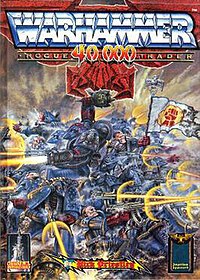
Warhammer 40,000 is a miniature wargame produced by Games Workshop. It is the most popular miniature wargame in the world, and is particularly popular in the United Kingdom. The first edition of the rulebook was published in September 1987, and the tenth and current edition was released in June 2023.

Games Workshop Group is a British manufacturer of miniature wargames, based in Nottingham, England. Its best-known products are Warhammer and Warhammer 40,000.
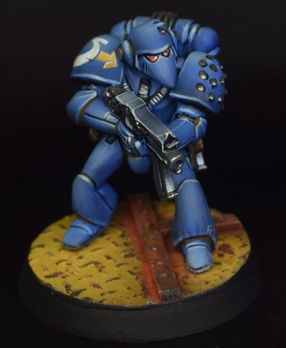
In the fictional universe of Warhammer 40,000, the Space Marines, also known as the Adeptus Astartes, are superhuman warrior-monks who fight for the Imperium of Man. They wear mechanised suits of armour and have modified genomes that grant them superhuman strength and endurance. Some Space Marines have betrayed the Imperium and serve the Gods of Chaos, and are thus known as Chaos Space Marines or Heretic Astartes.

Miniature wargaming is a form of wargaming in which military units are represented by miniature physical models on a model battlefield. Miniature wargames are played using model soldiers, vehicles, and artillery on a model battlefield, with the primary appeal being recreational rather than functional. Miniature wargames are played on custom-made battlefields, often with modular terrain, and abstract scaling is used to adapt real-world ranges to the limitations of table space. The use of physical models to represent military units is in contrast to other tabletop wargames that use abstract pieces such as counters or blocks, or computer wargames which use virtual models. The primary benefit of using models is immersion, though in certain wargames the size and shape of the models can have practical consequences on how the match plays out. Models' dimensions and positioning are crucial for measuring distances during gameplay. Issues concerning scale and accuracy compromise realism too much for most serious military applications.
Battlefleet Gothic is a naval miniature wargame that was produced by Games Workshop from 1999 to 2013 with Andy Chambers as the primary developer. A spin-off of the science-fantasy setting of Warhammer 40,000, the game has players command fleets of large spaceships belonging to one of several spaceborne factions. Although the wargame's miniatures and rulebooks are no longer supported by Games Workshop, two video game adaptations have been made since its cancellation in 2013.
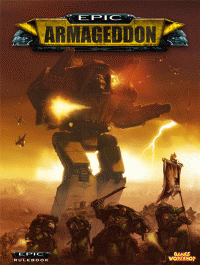
Epic is a collective term for a series of tabletop wargames set in the fictional Horus Heresy and Warhammer 40,000 universes. Whereas Warhammer 40,000 involves small battles between forces of a few squads of troops and two or three vehicles, Epic features battles between armies consisting of dozens of tanks and hundreds of soldiers. Due to the comparatively larger size of the battles, Epic miniatures are smaller, roughly one quarter the size of those in Warhammer 40,000, with a typical human being represented with a 6mm high figure, as opposed to the 28mm minis used in Warhammer 40,000. Since being first released in 1988 as Adeptus Titanicus, it has gone through various editions with varying names.

Warhammer is a tabletop miniature wargame with a medieval fantasy theme. The game was created by Bryan Ansell, Richard Halliwell, and Rick Priestley, and first published by the Games Workshop company in 1983.

Space Hulk is a board game for two players produced by Games Workshop. It was originally released in 1989. The game is set in the fictional universe of Warhammer 40,000. In the game, a "space hulk" is a mass of ancient, derelict space ships, asteroids, and other assorted space debris. One player takes the role of Space Marine Terminators, superhuman elite soldiers who have been sent to investigate such a space hulk. The second player takes the role of Tyranid Genestealers, the vanguard of an aggressive alien species which have made their home aboard the derelict ship.
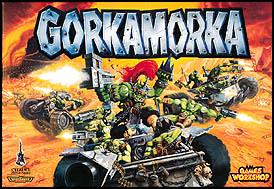
Gorkamorka is a tabletop skirmish wargame produced by Games Workshop. It is set on the desert world of Angelis in the Warhammer 40,000 setting, and prominently features Orks.
Battle for Armageddon is a strategic boardgame produced by Games Workshop. Unlike the many Games Workshop games that use miniatures, this is a more traditional counter and board game.
Inquisitor was a tabletop miniatures game based in Games Workshop's Warhammer 40,000 universe. Whereas the main line of Warhammer 40K games is based on squad based tactical warfare, Inquisitor focused on a small group of player characters akin to many role-playing games. Inquisitor miniatures are no longer produced by Games Workshop but, whilst they were, the game had its own website and 54 mm scale models were available as "Specialist Games" from the Games Workshop catalogue.

The Black Library is a division of Games Workshop which is devoted to publishing novels and audiobooks set in the Warhammer Fantasy Battle, Warhammer Age of Sigmar and Warhammer 40,000 fictional universes. Some of Black Library's best known titles include the Gaunt's Ghosts and Eisenhorn series of novels by Dan Abnett and the Gotrek and Felix series by William King and Nathan Long.
Aeronautica Imperialis is the name of two tabletop miniature wargames set within the Warhammer 40,000 universe. The games depict aerial warfare between different factions in the setting, either as one-off battles or as part of a larger narrative campaign. The first edition was released in January 2007 by Forge World, a division of the British gaming company Games Workshop. The second edition, a relaunch via Games Workshop, was released in August 2019 with a different ruleset and new, larger models.
Warhammer 40,000 Roleplay is a role-playing game system with multiple source books set within the Warhammer 40,000 universe. The first game using the system, Dark Heresy, was created by Black Industries, which closed soon after the initial release. Official support by Fantasy Flight Games was discontinued in September 2016. The license was later acquired by Ulisses Spiele, who published a new game, Wrath & Glory, in 2018.
Bryan Charles Ansell was a British role-playing and wargame designer. In 1985, he became managing director of Games Workshop, and eventually bought the company from Steve Jackson and Ian Livingstone. Ansell moved Games Workshop from London to Nottingham and refocused the company from role-playing games to Warhammer wargame and miniature products, which became very popular.

Richard "Rick" Priestley is an English miniature wargame designer and writer. He co-created the miniature wargame Warhammer Fantasy Battle and its science fiction counterpart Warhammer 40,000 during his tenure at Games Workshop in the 1980s and 1990s. Following his time at Games Workshop, he went on to establish Warlord Games and co-create other titles such as Bolt Action.
Jervis Johnson is an English tabletop game designer. He worked as a designer and manager for Games Workshop for over 38 years, and was the head of its Specialist Games studio. In addition to his work on Warhammer Fantasy Battles and Warhammer 40,000, he created the fantasy football game Blood Bowl, and co-created Epic 40,000, Necromunda, and Age of Sigmar.

Rogue Trader is a Science-fiction role-playing game published in 2009 that uses the Warhammer 40,000 Roleplay system.
Richard Fretson Halliwell was a British game designer who worked at Games Workshop (GW) during their seminal period in the 1980s, creating many of the games that would become central to GW's success.
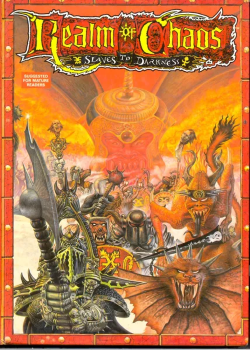
Realm of Chaos: Slaves to Darkness is a 1988 role-playing game supplement for Warhammer Fantasy Roleplay and Warhammer 40,000: Rogue Trader published by Games Workshop.
